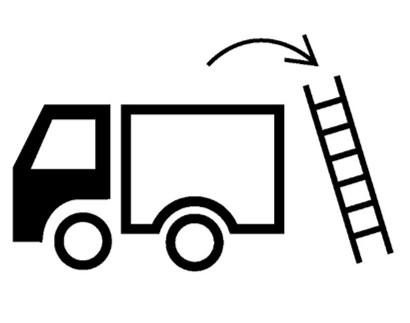Ladder & Equipment Racks
FAMA BUYER’S GUIDE TC056 Ladder & Equipment Racks
Ladder & Equipment Racks
Prepared by the FAMA Body Subcommittee
This guide does not endorse any manufacturer or product

Contents
Introduction
As fire apparatus continue to increase in size, ladder and equipment mounts have increased in popularity. They can mount to the side or roof of an apparatus and lowering equipment to a convenient height for safe retrieval.
Overview
Efficiency
The faster you can get a ladder off the apparatus the faster you can get to where it needs to be. Ladder systems eliminate the slow and awkward climbing that’s often involved with getting a heavy, 30-foot ladder off an apparatus. One firefighter flips a switch and the ladder lowers itself to shoulder height, ready for a quick hoist to your shoulder.
Utilizing a ladder system, especially one that stores the ladders over top of the apparatus, allows for much more compartment space in the apparatus body. An alternative storage method for ladders, suction hoses and pike poles may be through the tank. This keeps equipment low to the ground for safe retrieval.
Safety
“Slip & falls” and muscle strains are two of the most common injuries on the fire scene. Both of which can occur when trying to retrieve heavy ladders or other equipment, such as hard suction sleeves, from the side of an apparatus.
The more often your personnel’s feet leave the ground, the higher the risk for injury. The wet environment of a fire scene only increases this risk. Preventative steps should be taken to limit the amount of climbing, improper/imbalanced lifting of weight, and unnatural stretching required to retrieve a piece of equipment.
To combat this risk of injury, consider installing a Ladder/Equipment Lowering System, either manual or electrically/hydraulically powered.
Ladder Lowering Systems
Ladder Lowering Systems store your ladders close to the apparatus, and when needed, lower them to a convenient height for safe and easy retrieval. There are various options to consider when choosing your ladder rack, each with its own pros and cons:
Manual vs. Electric vs. Hydraulic
Manual
Manual systems, such as gantries, typically require the release of a thumb lock, and lower with a pull of a lever. While generally more economical, manual racks can require more physical effort to operate, and often cannot be utilized by a single firefighter. Manual racks occasionally require additional components inside the truck body, which can limit compartment storage capabilities.
Electric
Electric systems are powered by 12v electric actuators and lower at the flip of a switch. This switch should be installed in an area where the ladders are fully visible to the operator. Electric actuators, while more expensive that a manual system, allow one firefighter to lower the stored ladders with no physical effort. Additional safety locks may be required in areas where the apparatus is often maneuvering bumpy roads or railroad tracks to prevent the ladders from “creeping” down over time.
Hydraulic
Utilizes self-contained (no hoses) hydraulic actuators. While usually the most expensive option, hydraulic actuators allow for a smoother, more parallel lowering of the ladders. They also prevent actuator “creeping” which eliminates the need for additional safety locks. Depending on the manufacturer, hydraulic lifts can often carry more weight than their manual and electric counterparts.
Side-Mounted vs. Over-the-Top
Side-Mounted
Side-mounted systems sit on the apparatus side shelf or mount straight into a reinforced bulkhead wall. Ladders are stored tightly against the truck body. While typically, the less expensive option, side-mounted systems often take up space that would otherwise be used for additional compartments. To counter this, some manufacturers offer “extended” models with greater lowering capabilities, allowing you to mount to a high side shelf and still take advantage of compartments in the body below.
Over-the-Top
These systems store the ladders on top of the apparatus, usually lowering them with a single, powerful boom mounted in the center of the side body. This keeps the ladders up and out of the way until needed, while allowing for compartments in the side body below and occasionally a larger water tank. While generally, the more expensive option, the powerful boom often allows for a greater maximum lifting capacity. Not viable for apparatus with little to no available roof space, such as ladder trucks & aerial/towers.
Portable Tank and Hard Suction Systems
In addition to ladders, many popular lifting & lowering systems can be modified by the manufacturer to store hard suction sleeves or portable tanks as well.
Manual gantries can retrieve a single hard sleeve off the roof of an apparatus, while the automated electric and hydraulic systems typically accommodate 3-4 sleeves. A single firefighter can lower the sleeves and carry one off with minimal effort. Plus, the chances of a loose sleeve whapping and damaging the side of your apparatus are greatly diminished.
Portable tanks are one of the heaviest pieces of equipment on the apparatus, bulky and difficult to carry. Instead of struggling with getting one off the truck yourself, straining your body, scratching your truck up, and wasting precious time, consider using a lift system.
Plan ahead- you can even mount a ladder lift to one side of the apparatus and a hard sleeve/portable tank lift to the other! The long-term benefits of a lift system can greatly outweigh the short-term costs. Find the system that works best for you.
